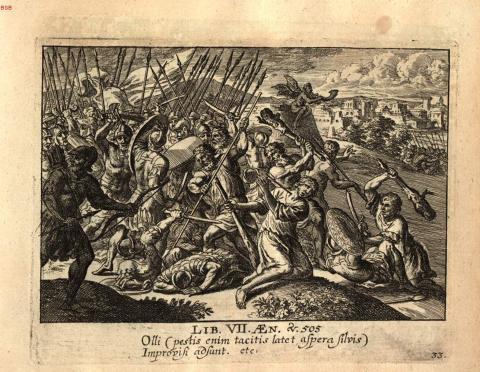Annotations
This engraving depicts the armed struggle between rural Latin farmers and regular armed Trojan warriors; in the background, apparently seated on a rock, Allecto blasts a horn.
Kampf zwischen ländlich bewaffneten latinischen Bauern und regulär gerüsteten trojanischen Kriegern; im Hintergrund blast die offenbar auf einem Felsen sitzende Allecto in ein Horn. (Suerbaum)
Engraving from a German children’s picture-book version of the Aeneid by G. J. Lang and G. C. Eimmart, “A tapestry of Roman virtues as seen in Vergil’s Aeneas and his brave deeds, rendered in sparkling engravings, as illustrations of the remarkable deeds of antiquity, for the common benefit of noble youth,” (Peplus virtutum Romanarum in Aenea Virgiliano eiusque rebus fortiter gestis, ad maiorem antiquitatis et rerum lucem, communi iuventutis sacratae bono, aere renitens) (Nuremburg: J.L. Buggel, 1688), pl. 33.


At lines 511-518 Virgil describes Allecto blowing on her horn to signal the start of the war as an epic moment heard all over the countryside. Both the Latins and the Trojans respond quickly to its call. The youth in the foreground falling with an arrow in his neck is probably Almo, Tyrrheus’ eldest son, whose death is described at 531-533. (Lucy McInerney)